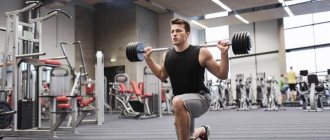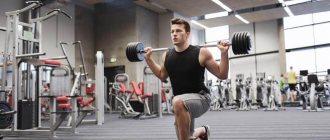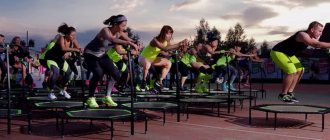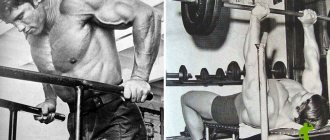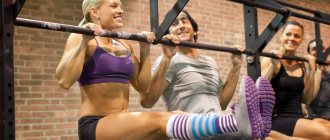© stock_alexfamous — stock.adobe.com
Share:
What you need
- Barbell
- Exercise equipment
- Dumbbells
- Horizontal bar
Pumping (from the English verb to pump - “pump up”) is a training method aimed at maximizing blood supply to the muscles and their maximum increase in volume during the training process. Pumping training is practiced mainly by bodybuilders, but athletes of other strength sports will also find certain advantages in them. We will tell you which ones exactly in this article.
What is Pumping
Literally, pumping is pumping, filling. This term comes from the English verb “to pump”. Frequent repetition of the same movement increases muscle blood flow and leads to tissue swelling. At the same time, the concentration of sugar and water increases many times over, the permeability of the cell membrane increases, which creates a feeling of muscle expansion in a specific area of the body.
The pumping effect can be achieved by gradually reducing the weight of the sports equipment, but increasing the speed of training movements and the number of repetitions. During training, it is necessary to maintain amplitude and perform each action as intensely as possible, overcoming pain. At the end of the exercise, the athlete increases the pace, while the blood supply to the tissues increases, and at the end of the workout the muscles increase in volume by up to 20%.
History of origin
To popularize fitness classes among men and women of different ages and professions, a married couple from New Zealand, Philip and Jackie Mills, came up with a way to make strength aerobics more fun and at the same time effective. In 1991 they held their first training session in Auckland. The program developed by the athlete and his wife began to rapidly gain popularity, and after 6 years, gyms and instructors from other countries began operating under the franchise.
Officially, the method belongs to the Les Mills company, and more than 17 thousand fitness clubs around the world practice it. The training is chosen for its combination of positive effects on health - improved muscle tone, stimulation of blood supply to internal organs and visual transformation. It is also important that during classes you do not need to run or jump, and even beginners can achieve success with a competent approach to the training process.
Body reaction to pumping training
Pumping works physiologically this way:
- The same movements, when duplicated at high speed, lead to the nervous system working in a stressful mode. The brain centers promote increased acceleration of blood flow and send all the necessary substances to the tissues;
- Muscle fibers facilitate the penetration of blood cells into them, which cannot exit immediately due to compression of the capillaries and high tension;
- When the exercise is repeated after a long break, the pressure in the fibers decreases and the blood gradually flows in the opposite direction. Ultimately, the muscle tissue returns to its normal state.
Muscle pumping does not consolidate the result and is called “cosmetic”. Most often it is used by bodybuilders in competitions before going on stage. But if you wish, you can try to develop it into a “productive” form.
“Productive” pumping is adding exercises without rapid repetitions. At some point, increased blood flow is formed, which leads to euphoria. From a psychological point of view, this gives strength and has a great effect on the intensity of the next workout. This constant practice warms up the fascia (the “bags” that contain the muscles) and makes them easier to stretch.
You can achieve muscle swelling with the help of sports nutrition and pharmacology - injections, tablets. But the so-called “Pharmacological” pumping proceeds artificially and can be fraught with health hazards if the sports nutrition is improper.
Video: What is pumping. Its varieties
Who can do it?
It is better for people who are more or less prepared to lift a barbell. Still, these are exercises with weights. Therefore, they are not suitable for beginners. In addition, it is far from easy for beginners to complete the entire workout. And the next day they simply cannot avoid the consequences in the form of sore throat.
This workout will be ideal for people who do not like to work out in the gym. Since the pump is also suitable for home exercises, it brings double joy to those who cannot stand stuffy and crowded places. However, for those who love exercise equipment, it is also suitable. To do this, just attend a group class at a fitness club.
Pros and cons of pumping
Advantages:
- Pumping does not imply the use of maximum weights. Ligaments and joints are not overloaded during the “saving” mode.
- Since the work is carried out mainly with light weights, the muscles are not damaged as much, which means they recover faster. This same point can also be attributed to the disadvantages of pump training (more on this below);
- The worked part of the body from the rush of blood becomes outwardly attractive - the most convex and prominent;
- The muscle fibers become clogged with lactic acid. This activates increased production of testosterone and somatotropin (growth hormone);
- With the help of open capillaries, thinned membranes of dilated cells and accelerated blood flow, oxygen and nutrients are very quickly delivered to the muscles and are absorbed many times better;
- A dense “cover” is formed around the muscle with the help of connective tissue, which serves as protection from vibrations, shocks, etc. Its advantages are that during training it stretches gradually, its length reserve increases, it can withstand maximum loads and does not tear;
- Constant pumping burns excess subcutaneous fat and forms a clear profile in a very short time.
Flaws:
- The biggest disadvantage of pump training is that you cannot build muscle mass with it. Many studies talk about this. But, 1 or 2 times a month, an athlete can practice pump training in order to “surprise the muscles,” since everyone knows that they get used to monotonous training;
- Each pumping workout is done in the final approach until severe pain occurs. This is not always a desirable and pleasant activity after a heavy strength training session;
- If you overuse intensive and long-term “cosmetic” pumping, it leads to muscle burning. This is dangerous for people who have difficulty gaining weight;
- The nervous system is exhausted - a sign of a stressful state comes from pumping to the brain. The disadvantages are that if repeated frequently it leads to mental overload.
Recommendations for those involved
Before you start pump training, it is worth considering a number of recommendations that will help you get a good result:
- The weight of the bar should be selected independently. It should not be light (there is no necessary load) or too heavy (it is difficult to maintain the technique). The weight of the barbell depends on the intensity and your physical capabilities.
- During training, do not round your back. Keep your knees slightly bent. When performing lunges, your knees should not go forward of your toes.
- To pump up your legs and buttocks, add barbell weight. Squeeze your buttocks while performing pump exercises.
- If you are not in the best physical shape, do not overdo it. Experienced athletes push their body much harder than you do. Don't chase them.
- In every lesson you fight with yourself, with fears and laziness. Increase the load gradually and set yourself a goal.
- Follow the trainer's instructions. Proper execution of the exercises will ensure the effectiveness of the exercise and help avoid injury. If you have any doubts about the correct execution of the pump exercise, contact your trainer.
- To feel comfortable during training, give preference to clothes made from “sports synthetics”. It “fits” the figure, is breathable and wear-resistant.
- Training should be regular. The creators of Body Pump recommend exercising 2-4 times a week. Don't miss classes. With long breaks, the transformation process will take quite a long time.
Types of Pumping training
Pumping muscles with blood is carried out in several ways. Complexes can be alternated and combined. But not a single pumping workout is possible without strength loads.
Standard workouts
This complex includes basic exercises with dumbbells or a barbell. A large number of repetitions are performed with a minimum of intervals. You can also use the simplest and most well-known exercise for pumping the pectoral muscles - push-ups.
Drop set
This method is also called “Dropping” and consists of performing strength work with a minimum break between approaches and gradually reducing the weight. An example of such pumping training could be the following sets:
Standing dumbbell bicep curls:
- 2 sets of 10 times with a 5-kilogram apparatus in each hand;
- The third approach is 8 times with the same weight, 4 and 5 – 16 times each with 3 kg dumbbells;
- Stretching exercise with final contraction of muscle fibers.
Calf raises on a Smith machine (working weight - 100 kg):
- 4 times 100 kg;
- 3 times 80 kg and 60 kg.
You will find all the necessary information about drop sets in this article.
Super set
It is the most effective pumping method, which combines two different exercises for one muscle group or muscle groups located next to each other. It is necessary to perform elements without skipping repetitions, respites or breaks, otherwise the effectiveness of pumping training will decrease. The athlete can choose the exercises and number of repetitions.
Best pairings for a super set:
- Biceps + triceps - a combination of dumbbell extension from behind the head in a sitting (or lying) position with a classic biceps curl;
- Biceps femoris + quadriceps femoris - performing seated leg extensions and leg presses with working weight.
We wrote in detail about supersets in this article.
Peak contraction
The exercises are performed as usual, but during the approach it is necessary to hold at the very peak for a couple of seconds. For example, when bending your arms with dumbbells, the delay occurs at the highest point.
Partial repetition
This method is recommended to be performed before completing a workout, when you feel tired. Pumping exercises with partial repetitions are very effective, although they are not done at full strength, but at 1/2-1/4 amplitude (shortened amplitude). This may cause severe tingling or burning in the muscles, but this is normal. It is also necessary to observe the number of repetitions from 8 to 10 or more.
Pre-fatigue
This is a very heavy type of pump, but quite effective, with a long-lasting effect. The bottom line is that you initially need to isolate the muscle, and then load it almost to failure. The training program may include the following exercises:
- For triceps: a combination of bench press with a narrow grip and extension of the arms in a block machine;
- On the legs: seated leg extension combined with classic squats.
It is better for novice athletes not to use this type due to its increased risk of injury.
Burning
First, the exercises are performed as usual. But as soon as the athlete feels tired, he begins to sharply increase his speed until his power reserves are fully exhausted.
Interesting facts about Body Pump group classes:
- such aerobics is not aimed at gaining muscle mass, but at breaking down fat cells, so it is suitable for those who intend to become slim as quickly as possible;
- pump fitness is popular in more than a hundred countries around the world, including many people who practice remotely and attend group master classes;
- the set of exercises and even musical compositions are the same all over the world, and in order to have the right to conduct them, gyms and instructors need to be certified;
- classic strength training takes 60 minutes, and to achieve optimal results without harm to health, experts recommend maintaining a 1-2-day interval between workouts;
- In addition to the mini-barbell, participants use a step platform and dumbbells during the class. 10 years ago SmartBar, SmartStep, SmartDisk were patented. The total weight of the equipment varies between 2-20 kilograms.


